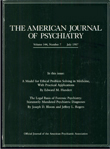Following World War II, in the bloom of dynamic psychiatry, merged departments of psychiatry and neurology separated into individual components. As our understanding of the fundamental role of the nervous system in psychiatry has developed, it would seem that this divorce was premature and in error. Nevertheless, a reconciliation is possible only at a modest level. For the sake of the patients, it is necessary for practicing psychiatrists to develop a reasonable level of sophistication concerning the operation of the nervous system. Textbooks of neurology are essential in this regard because residency training programs, until recently, have emphasized interpersonal and dynamic theory rather than integrating neuroanatomy and neurophysiology into the curriculum.
This small volume is designed for nonneurologists and is also designed to be carried in a jacket pocket. It is a clear, concise, and useful summary of clinical neurology for physicians, particularly for house officers. It is an excellent source for nonpsychiatric physicians but, unfortunately, does not meet the needs of psychiatric practitioners. As is to be expected from its intended audience, the book emphasizes the recognition and treatment of the usual neurological conditions, ranging from vascular to degenerative to neoplastic. This is not the daily fare of psychiatrists. There is virtually no recognition of behavioral disorders. Nevertheless, the chapters on neuroanatomy and the basic neurological examination are good reviews. It is almost sad to see how much better many aspects of the mental status examination are described in this book than the examination is conducted by many candidates on board examinations. The inadequacy of performance on mental status examinations reflects the inadequacy of the teaching in many residency programs. The proper teaching of the examination requires not only time and effort but the involvement of senior faculty. It should not be taught by the senior resident or inexperienced faculty. The mental status examination remains a sensitive diagnostic tool when used properly, and many psychiatrists would benefit from reading the few pages on this subject in Neurology for Non-Neurologists.
Despite the depredations of managed care, psychiatrists still have the luxury of spending more time with their patients than most clinicians. For this reason we are able to serve as surrogate primary care physicians for many patients. The recognition and differential diagnosis of a variety of neurological conditions, including early dementia and transient ischemic attack, can be recognized in the psychiatrist's office and confirmed elsewhere. The recognition by the psychiatrist of medical illness is not restricted to neurological conditions. Many endocrine, cardiac, respiratory, and allergic disorders can be recognized and referred appropriately. If psychiatrists perform this function, they will strengthen the necessity of the field in the face of the economic “experts” who believe—or at least pretend to believe—that nonphysician mental health practitioners are equal in quality to psychiatric physicians as well as lower in cost for patients other than themselves.

